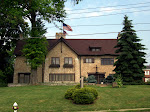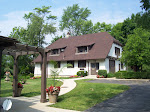
Natural salt springs were originally located in what is now Weathersfield Township, Trumbull County near present day Niles. Maps dated circa 1755 identified the location, known to early settlers and trappers, as well as Native Americans. Although the springs contained a low concentration of salt, it was an important staple for man and beast alike. The name Mahoning is believed to be derived from the native term for salt lick.
 General Samuel Holden Parsons set out to purchase 25,000 acres of land from the state of Connecticut, which included parts of the current townships of Lordstown, Weathersfield, Jackson and Austintown, encompassing the salt springs. As a result this area became known as the Salt Springs Tract. Parsons traveled to the area and set up a station to extract the salt by the process of boiling, but drowned in November 1789 prior to fully completing the purchase of the land. Parson’s holdings reverted to the state of Connecticut which later sold off the tract in parcels, including the sought after salt springs. Cabins were built near the springs to serve as shelter for those who sought out the mineral.
General Samuel Holden Parsons set out to purchase 25,000 acres of land from the state of Connecticut, which included parts of the current townships of Lordstown, Weathersfield, Jackson and Austintown, encompassing the salt springs. As a result this area became known as the Salt Springs Tract. Parsons traveled to the area and set up a station to extract the salt by the process of boiling, but drowned in November 1789 prior to fully completing the purchase of the land. Parson’s holdings reverted to the state of Connecticut which later sold off the tract in parcels, including the sought after salt springs. Cabins were built near the springs to serve as shelter for those who sought out the mineral.
Howe, Henry. Historical Collections of Ohio, Volume II. Cincinnati, OH: C. J. Krehbiel & Co., pages 175-178 and pages 659-662.
Above: Illustration of the Salt Springs, unidentified source
Below: portion of Henshaw's Map of Trumbull County showing location of Salt Springs, 1830
 General Samuel Holden Parsons set out to purchase 25,000 acres of land from the state of Connecticut, which included parts of the current townships of Lordstown, Weathersfield, Jackson and Austintown, encompassing the salt springs. As a result this area became known as the Salt Springs Tract. Parsons traveled to the area and set up a station to extract the salt by the process of boiling, but drowned in November 1789 prior to fully completing the purchase of the land. Parson’s holdings reverted to the state of Connecticut which later sold off the tract in parcels, including the sought after salt springs. Cabins were built near the springs to serve as shelter for those who sought out the mineral.
General Samuel Holden Parsons set out to purchase 25,000 acres of land from the state of Connecticut, which included parts of the current townships of Lordstown, Weathersfield, Jackson and Austintown, encompassing the salt springs. As a result this area became known as the Salt Springs Tract. Parsons traveled to the area and set up a station to extract the salt by the process of boiling, but drowned in November 1789 prior to fully completing the purchase of the land. Parson’s holdings reverted to the state of Connecticut which later sold off the tract in parcels, including the sought after salt springs. Cabins were built near the springs to serve as shelter for those who sought out the mineral.Views showing location of the Salt Springs, taken by James L. Wick, Jr. August 11, 1963
The level of saline contained in the water was not sufficient for its use to continue much past the early 1800s. Later much of the original springs were covered by tracks laid by the Baltimore and Ohio Railroad Company. In 1952 a small spring still bubbled “through a drain tile” winding “through a small valley off the Carson-Salt Spring Road.”
Historical Collections of the Mahoning Valley, Volume I. Youngstown: Mahoning Valley Historical Society, 1876, pages 172-173.
Przelomski, Ann N. “Salt Spring Once Important to Area.” Vindicator, 13 April 1952, page A-24.
Przelomski, Ann N. “Salt Spring Once Important to Area.” Vindicator, 13 April 1952, page A-24.
Howe, Henry. Historical Collections of Ohio, Volume II. Cincinnati, OH: C. J. Krehbiel & Co., pages 175-178 and pages 659-662.









2 comments:
From warren and I always wondered where it was located. Im familiar with the local history but could never locate it directly.
Post a Comment